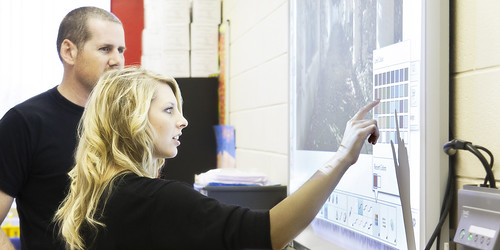Digital Blog Post #1- Chapter 1
1) First, Technology is used a lot inside the classroom now a days. Students and teachers use tablets, smart phones, and even laptops in ways students can learn with topic related videos or articles they find while surfing the web. With the use of laptops there are 3 basic categories to chose from: Ultra-portable, Thin-and-light, and Midsize. I honestly did not know the types of laptops there are, and I was surprised when I was reading this chapter, because I thought a "Laptop is a Laptop". Little did I know, that was not the case. As referenced by Maloy, et al, in chapter 1, "High quality laptops offer substantial battery life, an easy-to-read screen display in all kinds of light, sufficient memory to run multiple applications, and enough processing speed to handle downloading information and processing files"(2013, pp. 6-7). Although I am not a computer geek, and I have much to learn about computers/laptops, in my classroom I would have a few laptops around the room for my students so they can do projects using power point etc. and also they could do homework. When using technology in the classroom we can all learn things we did not know before about laptops like how they are made and how they work. This article, How Stuff Works explains very well the pieces of a laptop and how it works.
2) Second, I was very interested to read about TPACK since I had never heard of it before. TPACK stands for technological pedagogical content knowledge. It explains that while using technology for student learning you can use curriculum and pedagogy while not focusing mainly on one or the other when teaching to elementary and or secondary school children in the classroom. I hope to learn more about TPACK and the positives that come out of it through this class. The video I posted below explains more about what TPACK is. Also I will be posting a video below of 2 elementary school teachers in Texas using TPACK with their students. (I know she wanted 3 minutes or less with the videos, and this is about 6 minutes, but I think this video shows TPACK very well!!)
2) Second, I was very interested to read about TPACK since I had never heard of it before. TPACK stands for technological pedagogical content knowledge. It explains that while using technology for student learning you can use curriculum and pedagogy while not focusing mainly on one or the other when teaching to elementary and or secondary school children in the classroom. I hope to learn more about TPACK and the positives that come out of it through this class. The video I posted below explains more about what TPACK is. Also I will be posting a video below of 2 elementary school teachers in Texas using TPACK with their students. (I know she wanted 3 minutes or less with the videos, and this is about 6 minutes, but I think this video shows TPACK very well!!)
3) Third, Technology devices can be used in many ways in the class room. When people use laptops or smart phones/ipods to go on social media, especially children in this generation, they mainly go on twitter, facebook, instagram etc. to become social with family and friends. It can also be a learning experience for some. As referenced by Maloy, et al, in chapter 1, "An Ipod, for example, is a device to play music. Add a speaker and it becomes an entire classroom listening technology that plays songs, pod casts, and other recordings for students"(2013, pp. 13). Also when you go on twitter or facebook you can scroll upon educational videos or learn all the recent drama their is with celebrities that pop up all over as you surf the web. In a more school related focus, instead of holding around all your bulky textbooks, you can now purchase E-books and have all your reading done in the palm of your hand or on a laptop. When I become a teacher I will be using laptops in my class room and hopefully a smart board as well. Social media can be used educationally in the classroom or for amusement will all these devices out there being sold today.
In Conclusion, their is so many things 21st century teachers can benefit from when using technology in their classrooms. It will keep teachers more productive and not always having to read the material being taught from the textbook. When I was in high school I remember when teachers taught word for word from the textbook and how boring it was until we got smart boards. Technology will also benefit the students because they become more out to learn when surfing the web etc. for what they are learning in class and they will also become more imaginative when it comes to projects that are being assigned. Chapter 1 from Transforming Learning with New Technologies is a very good textbook to read to find out some of the many things you can do while using technology in school for learning!
 |
| Photo credit to queensu on Flickr |
Resources:
Flores, A. [Ashley Flores]. (2013, June 23). TPACK Example. [Video File]. Retrieved from
Kimmons, R. [Royce Kimmons]. (2011, Mar. 22). TPACK in 3 Minutes. [Video File]. Retrieved
Maloy, R., O'Loughlin, R., Edwards, S., & Woolf, B. (2013). Transforming Learning with New Technologies. 2nd Edition. Boston, MA: Pearson Education Inc.
Wilson, T., Valdes, R. How Laptops Work. Retrieved from
No comments:
Post a Comment